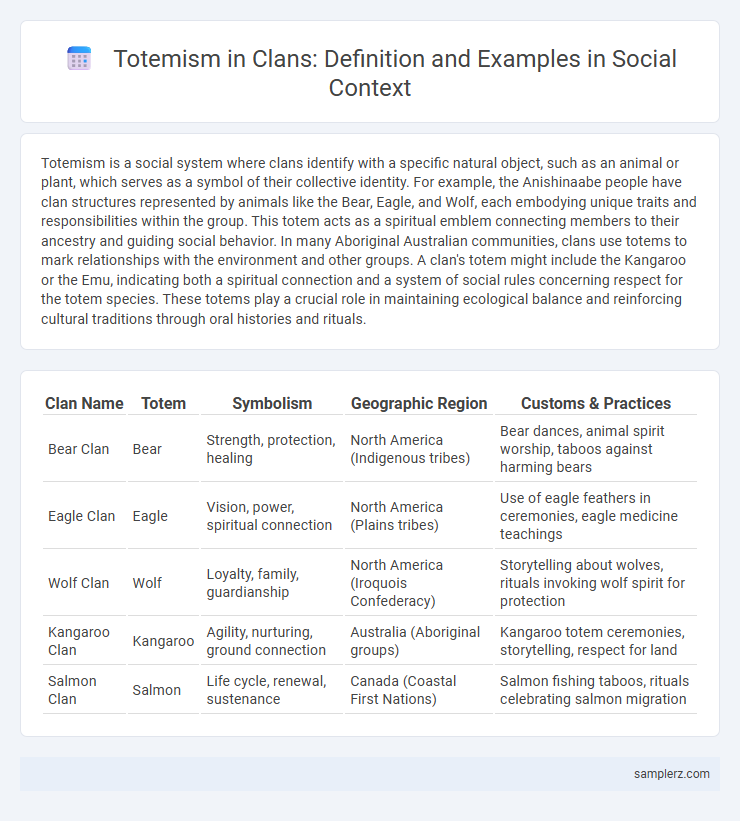Totemism is a social system where clans identify with a specific natural object, such as an animal or plant, which serves as a symbol of their collective identity. For example, the Anishinaabe people have clan structures represented by animals like the Bear, Eagle, and Wolf, each embodying unique traits and responsibilities within the group. This totem acts as a spiritual emblem connecting members to their ancestry and guiding social behavior. In many Aboriginal Australian communities, clans use totems to mark relationships with the environment and other groups. A clan's totem might include the Kangaroo or the Emu, indicating both a spiritual connection and a system of social rules concerning respect for the totem species. These totems play a crucial role in maintaining ecological balance and reinforcing cultural traditions through oral histories and rituals.
Table of Comparison
| Clan Name | Totem | Symbolism | Geographic Region | Customs & Practices |
|---|---|---|---|---|
| Bear Clan | Bear | Strength, protection, healing | North America (Indigenous tribes) | Bear dances, animal spirit worship, taboos against harming bears |
| Eagle Clan | Eagle | Vision, power, spiritual connection | North America (Plains tribes) | Use of eagle feathers in ceremonies, eagle medicine teachings |
| Wolf Clan | Wolf | Loyalty, family, guardianship | North America (Iroquois Confederacy) | Storytelling about wolves, rituals invoking wolf spirit for protection |
| Kangaroo Clan | Kangaroo | Agility, nurturing, ground connection | Australia (Aboriginal groups) | Kangaroo totem ceremonies, storytelling, respect for land |
| Salmon Clan | Salmon | Life cycle, renewal, sustenance | Canada (Coastal First Nations) | Salmon fishing taboos, rituals celebrating salmon migration |
Understanding Totemism: A Social Overview
Totemism in clan societies often centers around an emblematic animal or plant, serving as a spiritual symbol that fosters group identity and cohesion. Each clan member recognizes the totem as a representation of their ancestry and mutual obligations, deeply influencing social structure and ritual behavior. This symbolic system reinforces social bonds, guiding ethical conduct and community responsibilities within the clan.
Historical Roots of Clan Totemism
Clan totemism historically emerges from indigenous societies where animal or plant symbols represent kinship and spiritual connection, serving as emblematic ancestors and protectors. In Aboriginal Australian and Native American clans, totems reinforce social cohesion and identity through ritualistic practices and oral traditions. These totemic symbols often reflect ecological relationships, guiding clan responsibilities in resource management and territorial stewardship.
Totem Animals and Their Clan Significance
Totem animals symbolize the unique identity and spiritual connection of a clan, often embodying traits valued by the group such as strength, wisdom, or courage. For example, the bear represents protection and leadership in many Native American clans, while the eagle signifies vision and freedom in others. These totem animals serve as both guardians and ancestral guides, reinforcing social cohesion and cultural heritage within the clan.
Symbolic Roles of Totems in Clan Identity
Totemism in clans serves as a powerful symbolic system that reinforces social cohesion and collective identity through shared emblems, such as animals or plants, representing ancestral lineage and spiritual protection. These totems embody communal values and histories, guiding moral behavior and social responsibilities within the group. Clan members often perform rituals and maintain taboos linked to their totems, which strengthens group solidarity and distinguishes the clan from others.
Rituals Associated with Clan Totemism
Rituals associated with clan totemism often include ceremonies that honor the clan's totem animal or symbol, reinforcing group identity and social cohesion. These rituals may involve offerings, dances, and storytelling that transmit ancestral knowledge and spiritual connections. Participants uphold taboos related to the totem, ensuring respect and protection for the totem species or object within the community.
Totemism and Social Structure in Clans
Totemism in clans serves as a symbolic system where each clan identifies with a specific animal or natural object, which functions as an emblem of their collective identity and spiritual connection. This totemic affiliation regulates social behavior, marriage rules, and communal responsibilities, ensuring cohesion and continuity within the clan structure. Totems act as foundational elements in clan hierarchy and social organization, reinforcing kinship ties and cultural heritage.
Inter-Clan Relations and Totemic Taboos
Totemism in clans often shapes inter-clan relations by establishing symbolic identities linked to animals or natural elements, which enforce respect and mutual recognition among groups. Totemic taboos restrict the hunting, eating, or harming of clan totems, reinforcing social cohesion and preventing conflicts through shared cultural norms. These taboos also serve as mechanisms for diplomacy, ensuring peaceful coexistence and alliance-building between clans with different totemic affiliations.
Modern Examples of Totemism in Society
Modern examples of totemism in society include cultural symbols adopted by clans such as the Maori's use of the koru, representing growth and harmony. In urban communities, sports teams often serve as totems, uniting members through shared identity and loyalty, like the Chicago Bears for local fans. Environmental groups adopt animal totems, such as the wolf or eagle, symbolizing conservation and interconnectedness within their social movement.
Preservation of Totem Traditions in Clans
Totemism in clans serves as a vital cultural anchor, preserving identity through symbolic associations with animals or natural elements that embody clan values and heritage. Rituals, oral histories, and communal ceremonies ensure the transmission of totemic knowledge across generations, reinforcing social cohesion and respect for nature. This preservation highlights the enduring role of totemism in maintaining clan solidarity and spiritual connection within diverse indigenous societies.
The Future of Totemism in Social Contexts
Totemism in clans continues to evolve, serving as a powerful symbol of identity and social cohesion in communities navigating modernity. Emerging studies highlight how digital platforms enable clans to preserve ancestral totems, transforming traditional practices into interactive, virtual rituals that reinforce group solidarity. The future of totemism lies in its adaptability, blending ancient spiritual beliefs with contemporary social dynamics to maintain cultural continuity.

example of totemism in clan Infographic
 samplerz.com
samplerz.com